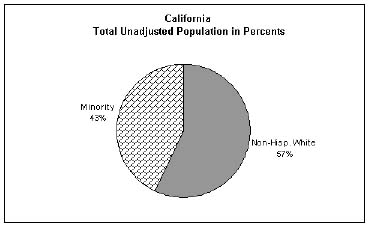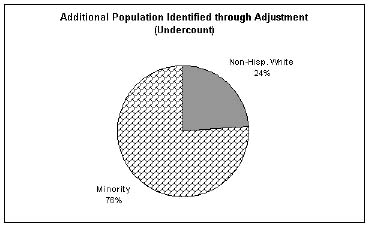State-by-State Analysis: California
The
1990 undercount and its demographic composition
As
indicated in Table 1, the percentage undercount of 2.8 percent in California
was higher than the national average of 1.6 percent and resulted in a net
numerical undercount of 837,557 persons, highest in the nation. For non-Hispanic
whites, Table 1 indicates that the undercount percentage was 1.2 percent
as compared to 5.0 percent for minority groups. As indicated in Table 2
and the summary chart below, these differentials between whites and minorities
resulted in an undercounted population with a much greater minority group
percentage than the state's total population. In California, non-Hispanic
whites comprised 57 percent of the state's uncorrected population, whereas
members of all minority groups combined comprised 43 percent. In contrast,
non-Hispanic whites comprised 24 percent of the state's undercounted population,
whereas members of all minority groups comprised 76 percent. In numerical
terms, the undercount consisted of 203,684 non-Hispanic whites and 633,873
members of minority groups.
Although
a majority of minority group members in California are Hispanic, the minority
population is diverse. According to corrected census data, non-Hispanic
blacks are 17 percent of California's minority population, Hispanics are
60 percent, and members of other minority groups are 23 percent. In California,
as in other states studied, Asian Americans comprise a majority of members
of minority groups other than non-Hispanic blacks and Hispanics.


Implications
of 1990 Census adjustment for minority voter opportunities
In
California, the use of corrected rather than uncorrected data
for the post-1990 redistricting would have had the potential to affect minority
voter opportunities in elections for Congress, the California State Senate,
and the California State Assembly. If corrected data rather than uncorrected
data had been used for the post-1990 apportionment of congressional districts
among states, a congressional district would have shifted from Wisconsin
to California, as a result of California's large minority percentage.7
The demographics of the undercount in California indicate that the additional
district may well have included a majority of minority group members and
thus have provided minority voters an enhanced opportunity to participate
in the political process and elect candidates of their choice.8
With
an additional congressional district, California would have had the potential
to create a minority-majority district in the heavily minority, Los Angeles
County region. The undercount in Los Angeles County alone comprised some
306,000 persons, 37 percent of the total state undercount and about 53 percent
of the population of an ideal congressional district in California.9
Moreover, some 271,000 of the undercounted persons in Los Angeles County
(89 percent) are members of minority groups, mostly Hispanics and blacks.
These minority group members would by themselves comprise 47 percent of
a congressional district. Within the Los Angeles region there are also several
congressional districts with populations greater than two-thirds minority
and thus could have lost minority population to a new district without sacrificing
minority voter opportunities. Examples include congressional districts 30,
31, 32, 33, 34, 35, and 37.
The
use of corrected data would also have had the potential to enhance minority
voter opportunities in the plans drawn for the California State Senate and
State Assembly, even though the number of seats in these plans would not
have changed. In the State Senate, even without changing a single district
line, the use of corrected data would have enhanced minority voter opportunities
by increasing the baseline of majority-minority districts against which
the next redistricting plan will be measured. One standard for the measurement
of whether a new district plan results in a diminution or "retrogression"
of
minority voter opportunities is whether the plan reduces the number of majority-minority
districts relative to the existing plan.10 In the post-1990 plan,
State Senate District 8 in the San Francisco area includes a minority population
of 49.8 percent. However, application of the corrected data for 1990 demonstrates
that the population of this District is more accurately measured at 50.4
percent.11 Although the minority percentage of Senate District
8 using uncorrected data can be rounded upward to 50 percent and thus be
counted as a 50 percent minority district, the district's minority percentage
using corrected data is clearly above the 50 percent mark.
In
the State Senate, the use of corrected rather than uncorrected data for
the post-1990 redistricting would also have presented the opportunity to
enhance the minority percentage of State Senate District 29, in Los Angeles
County, which has a 44.4 percent minority population. As indicated above,
the corrected data in the Los Angeles County region identified an additional
306,000 persons, including 271,000 members of minority groups. The additional
persons identified in Los Angeles County are more than is necessary to meet
one-person, one-vote requirements for State Senate Districts in this region.
Using corrected rather than uncorrected data, the ideal population of a
Senate district would increase from about 744,000 persons to about 765,000
persons, for a difference of about 21,000 persons.12
In
the California State Assembly, unlike the State Senate, there are no districts
with populations edging close to the 50 percent minority percentage. However,
the much smaller size of Assembly as compared to Senate districts in California
presented a greater opportunity to expand the minority percentage of Assembly
districts with minority populations close to or greater than 40 percent.
The ideal population of an Assembly district (about 382,000 persons for
corrected data) is half that of a Senate district. There are several districts
in the Los Angeles region with minority populations above 40 percent and
below 50 percent that might have been drawn with an enhanced minority population
with the use of corrected data. Examples include Assembly District 40 (41.7
percent minority), Assembly District 44 (41.8 percent minority), and Assembly
District 56 (44.3 percent minority). In addition, there are several districts
in the San Francisco area that also might have been drawn with an enhanced
minority population with the use of corrected data. Examples include Assembly
District 18 (41.3 percent minority), Assembly District 19 (42.3 percent
minority) and Assembly District 20 (44.0 percent minority). The corrected
data in San Francisco County and surrounding counties (Alameda, Contra Costa,
Marin, and San Mateo) identified about an additional 89,000 persons, 77
percent of whom were members of minority groups. The additional persons
identified in San Francisco and surrounding counties are more than is necessary
to meet one-person-one-vote requirements for State Assembly Districts in
this region.





